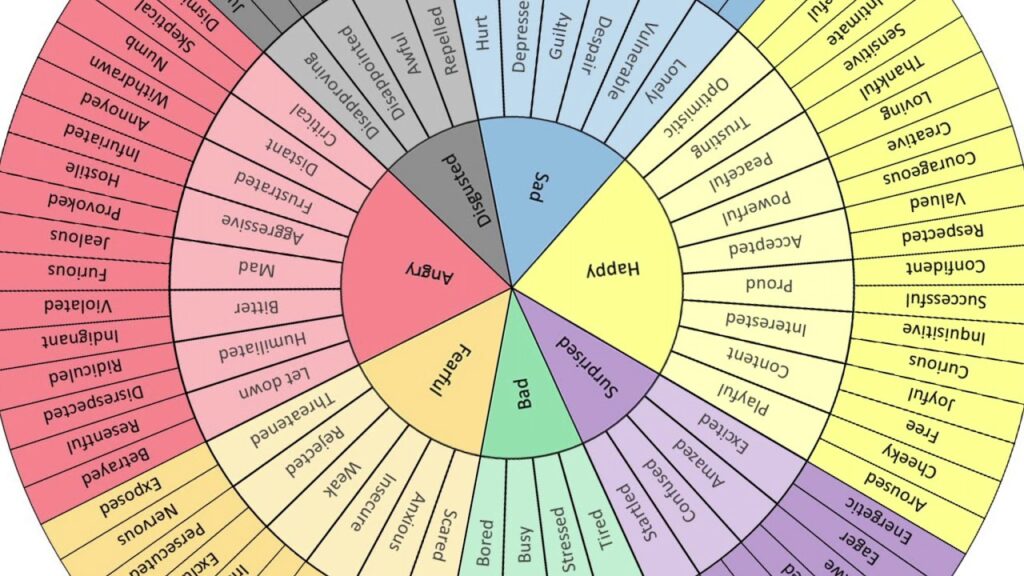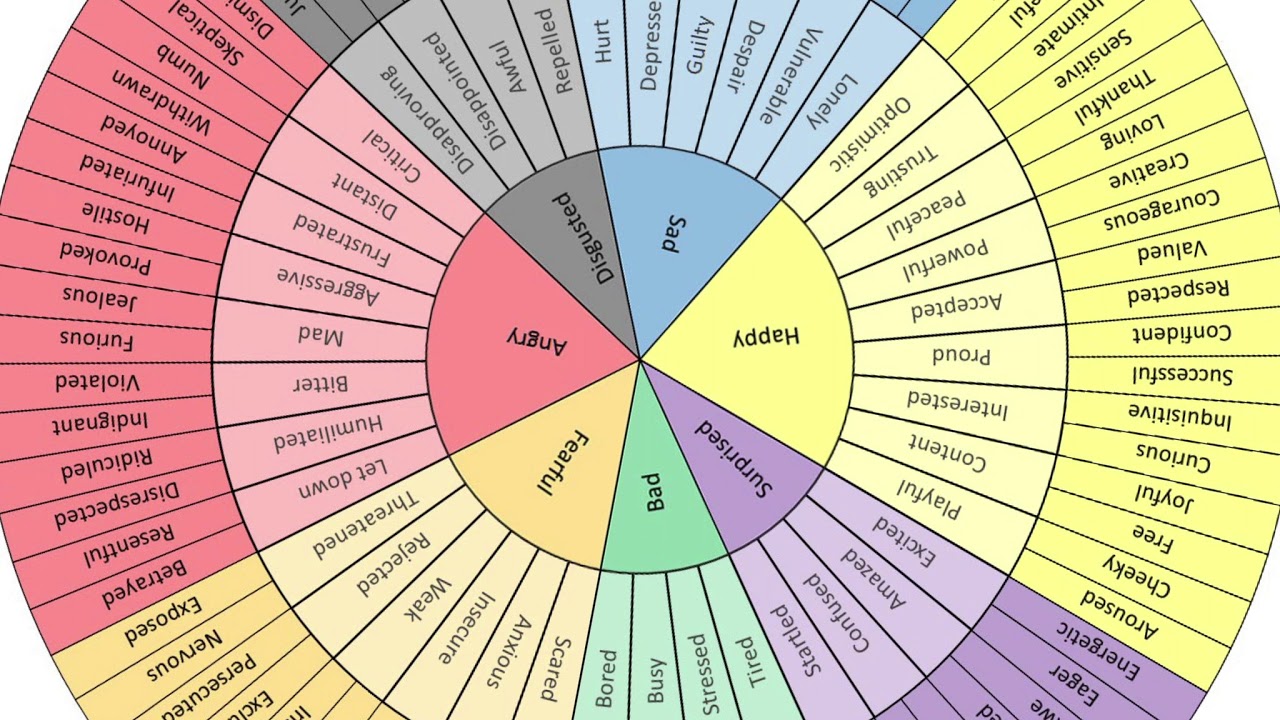
Unlock Your Emotions: A Comprehensive Guide to the Mood Wheel
Understanding and articulating your emotions can be challenging. Often, we struggle to find the right words to describe what we’re feeling, leading to frustration and miscommunication. This is where the mood wheel comes in handy. A mood wheel, also known as an emotion wheel, is a visual tool designed to help individuals identify and understand their feelings more accurately. This comprehensive guide will delve into the uses, benefits, and practical application of the mood wheel in various aspects of life.
What is a Mood Wheel?
A mood wheel is essentially a circular diagram that organizes emotions into different categories and subcategories. Typically, it starts with basic emotions in the center, such as happiness, sadness, anger, fear, and surprise. As you move outwards from the center, these basic emotions are further refined into more specific and nuanced feelings. For example, ‘happiness’ might branch out into ‘joyful,’ ‘content,’ ‘optimistic,’ and ‘grateful.’ The mood wheel provides a visual representation of the emotional spectrum, making it easier to pinpoint exactly what you’re experiencing.
The Origins of the Mood Wheel
While the exact origins are debated, the concept of organizing emotions visually has been around for a while. One of the most popular and influential versions of the mood wheel is attributed to Dr. Robert Plutchik, a psychologist who developed the ‘Wheel of Emotions’ in the 1980s. Plutchik’s wheel proposed eight basic emotions and their relationships, influencing many of the mood wheels we see today. His work laid the groundwork for understanding how emotions are connected and how they can blend to create more complex feelings.
Benefits of Using a Mood Wheel
Using a mood wheel offers a multitude of benefits, impacting both personal and interpersonal relationships. Here are some key advantages:
- Improved Emotional Awareness: The primary benefit is enhanced emotional literacy. By using the mood wheel, you become more attuned to your internal state and better able to identify and label your feelings.
- Enhanced Communication: Articulating your emotions accurately improves communication with others. The mood wheel provides a vocabulary for expressing complex feelings, reducing misunderstandings and fostering deeper connections.
- Better Self-Regulation: Understanding your emotions is the first step towards managing them. By recognizing your feelings, you can develop strategies to cope with difficult emotions and regulate your emotional responses.
- Increased Empathy: Using a mood wheel can also increase your empathy for others. By understanding the nuances of your own emotions, you become more sensitive to the emotional experiences of those around you.
- Reduced Stress and Anxiety: Identifying and processing emotions can reduce stress and anxiety. Suppressing emotions can lead to emotional build-up, but using a mood wheel allows for healthy expression and release.
How to Use a Mood Wheel Effectively
Using a mood wheel is straightforward, but here are some tips to maximize its effectiveness:
- Start with the Core Emotions: Begin by identifying the primary emotion you’re feeling. Is it happiness, sadness, anger, fear, or surprise?
- Explore the Subcategories: Once you’ve identified the core emotion, explore the subcategories on the mood wheel. Are you feeling joyful, content, or optimistic? Perhaps you’re feeling anxious, overwhelmed, or stressed.
- Consider the Intensity: Pay attention to the intensity of the emotion. Are you feeling slightly annoyed or intensely angry? Are you feeling a little sad or deeply depressed?
- Reflect on the Context: Consider the context in which you’re experiencing the emotion. What events or situations triggered this feeling? Understanding the context can provide valuable insights into your emotional patterns.
- Journal Your Findings: Write down your observations in a journal. This can help you track your emotional experiences over time and identify recurring patterns.
Applications of the Mood Wheel in Different Areas
The mood wheel is a versatile tool with applications in various fields:
Therapy and Counseling
Therapists often use mood wheels to help clients identify and process their emotions. It can be particularly helpful for individuals who struggle with emotional expression or who have difficulty understanding their feelings. The mood wheel can facilitate deeper self-exploration and promote emotional healing. [See also: Cognitive Behavioral Therapy Techniques]
Education
In educational settings, mood wheels can be used to teach children and adolescents about emotions. It can help them develop emotional literacy and improve their social-emotional skills. Teachers can use mood wheels to facilitate discussions about feelings and create a supportive classroom environment.
Personal Development
For personal development, the mood wheel can be used as a self-assessment tool. It can help individuals gain a better understanding of their emotional patterns and identify areas for growth. By tracking their emotions over time, individuals can develop strategies to manage their emotional well-being.
Workplace
In the workplace, mood wheels can be used to improve communication and teamwork. By encouraging employees to express their feelings openly and honestly, organizations can create a more positive and productive work environment. It can also aid in conflict resolution by helping individuals understand the emotions driving their interactions. Understanding your feelings at work is crucial for maintaining a healthy work-life balance.
Creating Your Own Mood Wheel
While many pre-made mood wheels are available online, you can also create your own to tailor it to your specific needs. Here’s how:
- Start with the Core Emotions: Begin with the basic emotions – happiness, sadness, anger, fear, and surprise – in the center of your wheel.
- Add Subcategories: Branch out from each core emotion and add subcategories that resonate with you. Consider the specific feelings you experience most often.
- Use Colors: Assign different colors to each emotion category. This can make the mood wheel more visually appealing and easier to use.
- Personalize It: Add your own unique emotions and expressions. The goal is to create a mood wheel that reflects your individual emotional landscape.
- Keep It Simple: While it’s important to be thorough, avoid making your mood wheel too complex. A simple and easy-to-use mood wheel will be more effective.
Different Types of Mood Wheels
Several variations of the mood wheel exist, each with its own unique approach to organizing emotions:
- Plutchik’s Wheel of Emotions: As mentioned earlier, Plutchik’s wheel is a foundational model that proposes eight basic emotions and their relationships.
- The Feeling Wheel: This mood wheel is often used in therapeutic settings and provides a comprehensive list of emotions and feelings.
- The Core Emotions Wheel: This wheel focuses on the primary emotions and their basic expressions, making it simple to use and understand.
- Personalized Mood Wheels: These wheels are custom-designed to reflect an individual’s specific emotional experiences.
Challenges and Limitations
While the mood wheel is a valuable tool, it’s important to acknowledge its limitations:
- Oversimplification: The mood wheel can sometimes oversimplify complex emotions. Human emotions are nuanced and multifaceted, and a wheel may not capture the full range of emotional experiences.
- Cultural Bias: Emotions can be expressed and understood differently across cultures. A mood wheel developed in one culture may not be universally applicable.
- Subjectivity: The interpretation of emotions is subjective. What one person considers ‘joyful,’ another might consider ‘content.’
- Not a Replacement for Professional Help: The mood wheel is a helpful tool, but it’s not a substitute for professional mental health care. If you’re struggling with persistent emotional difficulties, seek the guidance of a qualified therapist or counselor.
The Mood Wheel in Digital Applications
With the rise of digital technology, mood wheels have found their way into various apps and online platforms. These digital mood wheels often offer interactive features, such as the ability to track your emotions over time and receive personalized insights. They can be a convenient and accessible way to monitor your emotional well-being. Many mental health apps now incorporate a mood wheel to allow users to easily track their feelings. [See also: Best Mental Health Apps]
Conclusion: Embracing Emotional Awareness with the Mood Wheel
The mood wheel is a powerful tool for enhancing emotional awareness, improving communication, and promoting self-regulation. By providing a visual representation of the emotional spectrum, it makes it easier to identify and articulate your feelings. Whether you’re using it in therapy, education, personal development, or the workplace, the mood wheel can help you unlock a deeper understanding of your emotional landscape. While it’s important to be aware of its limitations, the mood wheel remains a valuable resource for anyone seeking to improve their emotional well-being. Embrace the mood wheel as a stepping stone towards a more emotionally intelligent and fulfilling life.

